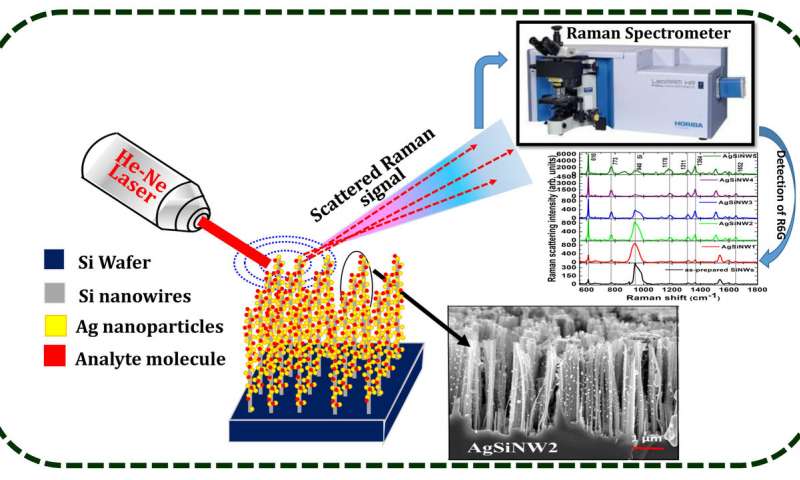

联系人:杨经理
电话:0510-85386636
手机:18001518665
尚蒙科技无锡有限公司
地址:江苏省无锡市新吴区菱湖大道228号天安智慧城A1-602

虽然纳米银已经用于表面增强拉曼散射的检测,但通过与三维结构的纳米硅线结合,却能达到更强的检测效果。最近印度yderabad大学的研究团队,通过纳米银装饰的3维纳米硅线作为激光拉曼的载体,对一些生化分子的探测灵敏度提高10万倍!具有极大的应用价值。结果发表在美国的应用物理杂志上。
As medicine and pharmacology investigate nanoscale processes, it has become increasingly important to identify and characterize different molecules. Raman spectroscopy, a technique that leverages the scattering of laser light to identify molecules, has a limited capacity to detect molecules in diluted samples because of low signal yield.
A team of researchers from the University of Hyderabad in India has improved molecular detection at low concentration levels by arranging nanoparticles on nanowires to enhance Raman spectroscopy. Surface-enhanced Raman spectroscopy (SERS) uses electromagnetic fields to improve Raman scattering and boost sensitivity in standard dyes such as R6G by more than one billionfold.
The team decorated vertically aligned silicon nanowires with varying densities of silver nanoparticles, utilizing and enhancing the structure's 3-D shape. Their results, published in the Journal of Applied Physics, show that their device was able to enhance the Raman signals for cytosine protein and ammonium perchlorate by a factor of 100,000.
"The beauty is that we can improve the density of these nanowires using simple chemistry," said Soma Venugopal Rao, one of the paper's authors. "If you have a large density of nanowires, you can put more silver nanoparticles into the substrate and can increase the sensitivity of the substrate."
Applying the necessary nanostructures to SERS devices remains a challenge for the field. Building these structures in three dimensions with silicon nanowires has garnered attention for their higher surface area and superior performance, but silicon nanowires are still expensive to produce.
Instead, the team was able to find a cheaper way to make silicon nanowires and used a technique called electroless etching to make a wide range of nanowires. They "decorated" these wires with silver nanoparticles with variable and controlled densities, which increased the nanowires' surface area.
"Optimizing these vertically aligned structures took a lot of time in the beginning," said Nageswara Rao, another of the paper's authors. "We increased the surface area and to do this we needed to change the aspect ratio."
After optimizing their system to detect Rhodamine dye on a nanomolar level, these new substrates the team built enhanced Raman sensitivity by a factor of 10,000 to 100,000. The substrates detected concentrations of cytosine, a nucleotide found in DNA, and ammonium perchlorate, a molecule with potential for detecting explosives, in as dilute concentrations as 50 and 10 micromolar, respectively.
The results have given the team reason to believe that it might soon be possible to detect compounds in concentrations on the scale of nanomolar or even picomolar, Nageswara Rao said. The team's work has opened several avenues for future research, from experimenting with different nanoparticles such as gold, increasing the sharpness of the nanowires or testing these devices across several types of molecules.
雷同的研究结果早在2005年利用纳米氧化硅载体来增强红外光谱的探测能力(Journal of Applied Physics 98, 114310 (2005); https://doi.org/10.1063/1.2138376)(Applied Surface Science,Volume 252, Issue 5, 15 December 2005, Pages 1197-1201)其探测能力提高1000倍。
More information: V. S. Vendamani et al, Three-dimensional hybrid silicon nanostructures for surface enhanced Raman spectroscopy based molecular detection, Journal of Applied Physics (2018). DOI: 10.1063/1.5000994
下一条: 石墨烯基电子穿戴纺织品商业化取得进展
地址:江苏省无锡市新吴区菱湖大道228号天安智慧城A1-602 :0510-85386636 传真:0510-85384339 电子邮箱:info@solmontech.com
: